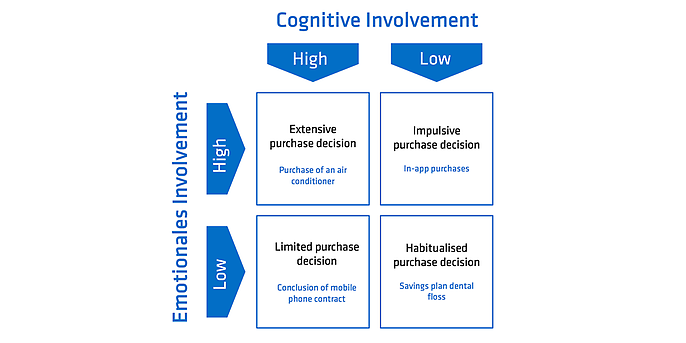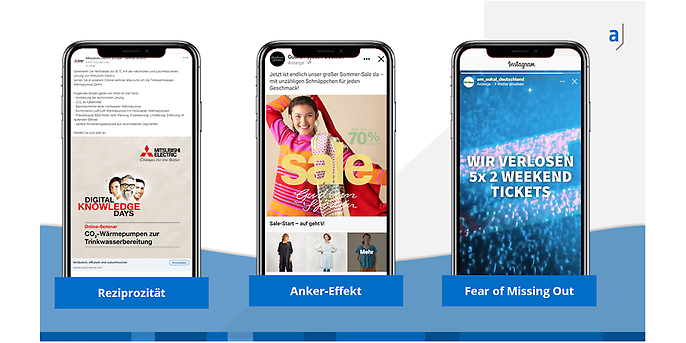17. April 2025 By Mia Rauchschindel
How to use psychological triggers and consumer buying behaviour for your next advertising campaign
In today's digital world, where consumers are exposed to a flood of advertising and an immense variety of products, it is more important than ever for companies to understand the purchasing behaviour of their target groups and to respond to it in a targeted manner. Current data from the Federal Statistical Office show that private consumer spending in Germany in 2024 rose by only 0.3% in price-adjusted terms compared to the previous year. This modest development indicates that many consumers are reconsidering their spending due to rising living costs and putting off major purchases.
Purchase motivation and purchase decision typologies
User purchasing behaviour is a complex phenomenon influenced by a variety of factors. These include personal likes and dislikes, general behavioural patterns, and social and cultural influences.
In order to better understand the different types of buyers, these can be assigned to purchase decision typologies in the form of an involvement matrix (as shown in the first figure).
In this context, a distinction is made between emotional involvement and cognitive involvement. Extensive purchase decisions are decisions that are thought about at length because they require a high level of involvement, both cognitively and emotionally. In contrast, an impulsive purchase decision is when it comes to a product that does not require comparisons or rational considerations, but where emotional benefits are present.
In contrast, limited purchase decisions have the opposite view (high cognitive involvement, low emotional involvement). Such product purchases are well-considered and rational. Finally, the habitualised purchase decision is the opposite of the extensive purchase decision (low cognitive and emotional involvement). These are purchases that are made without thinking and are usually always the same products.

This illustration shows the involvement matrix and contains the four purchase decisions (extensive purchase decision, impulsive purchase decision, limited purchase decision, habitualised purchase decision), divided according to emotional and cognitive involvement.
How can the involvement matrix support our ads?
The involvement matrix can help to segment your own products or services according to different target groups, so that you can focus your campaigns and advertising goals more efficiently on the correct target group.
Let's take an everyday object like a simple toothbrush as an example. I expect a low level of emotional and cognitive involvement from many users and thus a more impulsive buying behaviour. A user would start their user journey by looking for a toothbrush in the shop. They find a toothbrush in their favourite colour and then buy it. However, if the person already had a favourite toothbrush, they would choose it again and thus make a habitual purchase decision.
How would the whole process work if the toothbrush were electric? For this product, I expect the cognitive involvement and thus the information that a user needs before deciding to buy the product to increase. This means that the purchase decision is limited.
Finally, let's move away from the example of the toothbrush and look at a car instead. For many people, this purchase triggers an extensive purchase decision. The car should reflect one's own personality, but it should also be rationally explainable (e.g. price, technology) to oneself or one's neighbours.
By understanding these purchasing decision typologies and taking them into account in our campaigns, we can better assess the behaviour of the target group and accompany them more effectively through the respective decision-making process. If a product requires more cognitive effort, such as buying an air conditioner, the user journey could be expanded in this regard so that users receive more touchpoints with the company.
Achieve digital success with adesso
Increase sales and boost your company's success with performance marketing
Use your advertising budget where it really works: targeted, data-based and efficient. With adesso, you can use the full power of SEA, programmatic advertising and social ads – individually tailored to your goals and continuously optimised. We get your message exactly where your target group is – at the right time, on the right channel.
Psychological triggers in digital advertising
In addition to the different types of purchase decisions, there are a number of psychological triggers in digital advertising that we can use to influence users' purchasing behaviour. You should take a closer look at the following triggers so that you can benefit from them in your next campaign.
FOMO
FOMO stands for ‘Fear of Missing Out’ and describes the fear of missing out on something that others are allowed to experience. The FOMO effect is particularly common in today's digital world. For example, people are constantly getting glimpses of other people's experiences and activities through social media. Influencer marketing also likes to use this trigger. Influencers present various products or experiences that users then also want to try.
Through exclusive offers or time-limited promotions, FOMO can be used in digital marketing to increase engagement and sales.
Anchoring
Anchoring is a cognitive bias in which people rely too heavily on the first piece of information (the ‘anchor’) when making a decision. This first impression often influences subsequent judgements and decisions, even when the anchor is no longer present.
In marketing, this can have an effect on how the price is communicated, among other things. For example, if an advert states that the price (the anchor in this case) has been reduced, this reduced price is automatically perceived as a good offer, thus promoting the buying behaviour.
Reciprocity
The principle of reciprocity is based on the human tendency to reciprocate a gesture or favour received. This behaviour can be observed in many cultures worldwide and plays an important role in social interactions and relationships.
For example, advertising free information seminars, additional information or free samples online can lead to users feeling that they have to reciprocate the ‘friendly gesture’ and engage more with the brand. This trust can then be consolidated through consistently high quality and consistent brand communication.

This image shows three adesso advertising campaigns. The FOMO effect shows the Em-Eukal campaign, in which tickets for a festival were raffled. The anchoring effect shows an advertisement by Gudrun Sjöden, where there is currently a sale. The reciprocity trigger shows registration for a free information seminar on air source heat pumps.
Other triggers in advertising psychology
In addition to the triggers already mentioned, there are many others that are often used in marketing. These include, for example, the trigger sympathy, which attempts to create an emotional bond through authenticity. The influencing factor authority uses experts and certificates to build trust, and by creating scarcity or novelty, the interest and willingness to buy of the target group is further encouraged.
Your advertising campaigns in good hands
Understanding purchasing behaviour and using psychological triggers in digital advertising can have a significant impact on the success of your marketing strategies. We are happy to support you in developing a suitable user journey for your products or services and, together, we can create high-performance campaigns that benefit from our insights into advertising psychology.
If you want to delve a little deeper into the topic, we will be happy to advise you.

